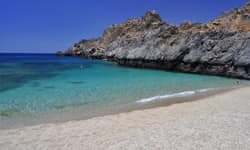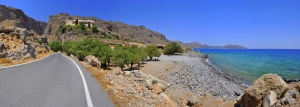On the E4 European trail that connects Sougia and Paleochora we meet the astonishing tiny beach of Astropelekita. We meet this beach to the east of Plaka stony cape and before starting ascending to Flomos Cape for reaching Lissos. This cove is a great chance to have a cooling bath while hiking the E4 trail.
The first beach of Xerokambos (on the west) is the harbor of Amatos. A natural harbor with calm waters is formed there with several boats. The remote beach is pebbly and is ideal for fishing. There are 2-3 tamarisk trees and a ramp for launching boats. The road leading to the harbor from the settlement of Xerokambos is an accessible dirt road. From here starts the path to the beach of Agia Irini.
To reach the beach you can walk into the small canyon, until you meet the sea. From Finokalias follow the short path that leads northwards, until you see the bed of the gorge. While walking along this, you will cross one beautiful and wild landscape with bare rocks, low vegetation and numerous spices and herbs.
East of the main beach of Hiona, there are several small coves, where you can find a quiet place to swim alone and nude. The first sandy beach is called Bondalaki. Continuing driving along a bad dirt track to the esat, you will soon meet several coves with pebbles and enjoy the eerie landscape with gorges and wild mounts in the background. The last cove is Skaria and is the easternmost beach of Crete. It is highly affected by the sea currents (there is a lot of rubbish). The previous beach, Pilos, is formed in clay ground and is ideal for seclusion.
A few yards south of Ammoudi beach, next to the coastal street of Akti Koundourou leading to Lake Voulismeni you will find a small artificial beach with sand. The beach of Akti Koundourou Street is formed between two concrete piers. It is well organized with umbrellas and water sports, while it hosts a diving school.
The beach is mainly rocky and with sand in parts, and a smaller nicer beach is formed north of the main beach. In recent years a large hotel unit in the region has made great interventions to the beach and has unfortunately altered completely the rocky character of the coast. A pier has been built to keep sand and to cover the rocks.
Kapsas Monastery is located 37km southwest of Sitia and 32km east of Ierapetra, between Makrigialos and Goudouras. It is a very old monastery built on the cliffs near the exit of the arid Pervolakia Gorge. To get here you can follow the paved road that links Makrigialos to Goudouras, but there are also (rare) bus services from Ierapetra.
Livadia coves are located near the village of Livadia, 72km southwest of Chania and 31km south of Kissamos. The coves are not popular to the visitors of the area, because they seem very rocky, as most beaches in west crete. They are mainly prefered by the residents and visitors of Livadia village and those who want to stay remote.

























































































